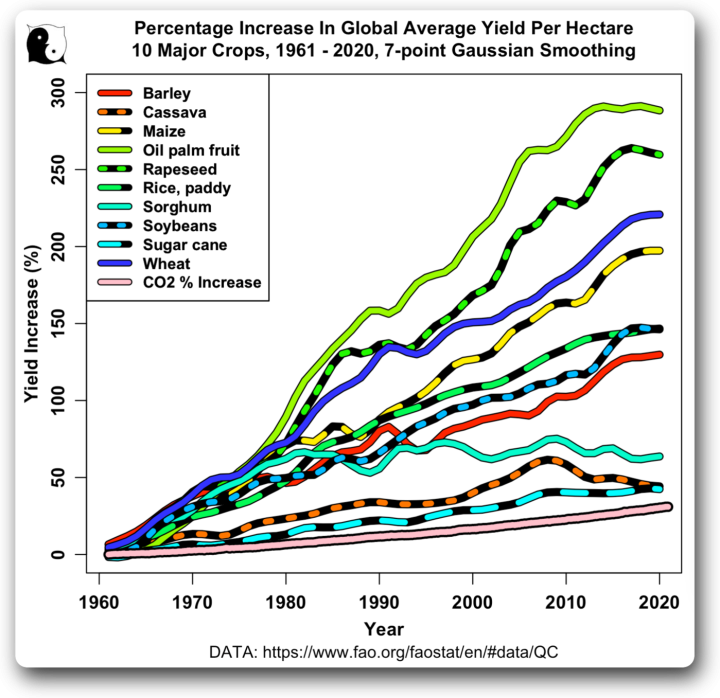Guest Post by Willis Eschenbach
I keep reading that increasing temperatures will cause decreasing yields of our food crops, resulting in widespread hunger … for example, the IPCC says:
Declines in yields and crop suitability are projected under higher temperatures, especially in tropical and semi-tropical regions. Heat stress reduces fruit set and speeds up development of annual vegetables, resulting in yield losses, impaired product quality, and increasing food loss and waste. … All models project an increase in the risk of hunger, with the median projection of an increase in the population at risk of insufficient energy intake by 6%, 14%, and 12% in 2050 for SSPs 1, 2 and 3 respectively.
But having grown up with farmers, this seemed improbable to me. Farmers are constantly modifying planting and harvest times, seed depth, irrigation schedules, and crop and varietal choices based on the weather in order to maximize yields. And they are very successful at it.
So I looked at the change in yields over time. I also included the change in airborne CO2 concentrations over the same period.

Figure 1. Percentage change in yields, ten major food crops, along with the percentage change in CO2.
Yields have been increasing, in fits and starts, despite increasing temperatures over the period of that record.
Today I realized that there was another way I could look at this. I figured that I could take a look at standardized crop yield by country versus the average temperature of the country, to see if the country’s temperature affected yield. Figure 2 shows the result for five different crops.

Figure 2. Yield versus temperature by country, 2020. All yield values are standardized to a mean of zero and a standard deviation of one. The dotted vertical line is at 18°C.
What I noticed when I plotted this up was that the yields fall into two groups—one for warm countries and one for cold countries. It was also obvious that the yields in the warmer countries were all lower.
So … why would this be? Well, my first thought was that it represented the difference between industrialized and non-industrialized nations. Farmers in industrialized nations have more fertilizer, tractors, detailed weather forecasts, refrigeration, machinery for plowing, seeding, weeding, harvesting, and the like. As a result, we’d expect industrialized nations to have higher yields. So to see which countries were where, I plotted up the temperatures, and divided them into those warmer and colder than 18°C.

Figure 3. Average temperatures, 2000 – 2020
Hmmm … almost all of the industrialized countries have an average temperature less than 18°C.
To close out the loop, I looked at the trends within each group of countries, those above and below 18°C. Here is that result.

Figure 4. As in Figure 3, but including the trend lines for each country group, above and below 18°C.
It turns out that within each group, the yields in the warmer countries are no better or worse than the yields in the cooler countries. And as a result, the claim that warming temperatures will cause widespread hunger is not supported by this analysis.
























Besides the gradual increase in agricultural yields, we’re also seeing rises in population and life expectancies, while global poverty levels and deaths from extreme weather events have been dropping. But as long as the mainstream media and governments are accepting donations from the major environmental groups to exaggerate the potential bad features of a warming climate, this type of hogwash will continue to be publicized. The good thing is that neither governments, businesses, industries nor consumers intend to make the big operational and lifestyle changes that supposedly will combat the “problem”.